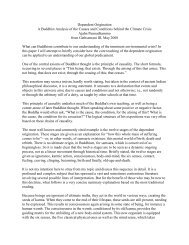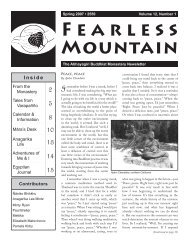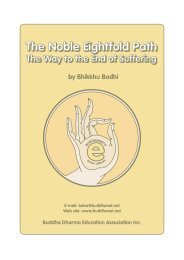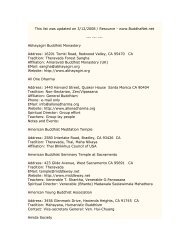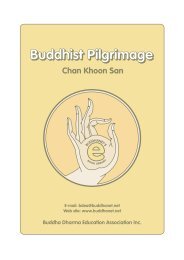No Hinayana in Buddhism - Urban Dharma
No Hinayana in Buddhism - Urban Dharma
No Hinayana in Buddhism - Urban Dharma
Create successful ePaper yourself
Turn your PDF publications into a flip-book with our unique Google optimized e-Paper software.
41) Some assert that the word <strong>H<strong>in</strong>ayana</strong> as a term for the earlier schools is a usage that belongsto the distant past only. This is not correct. It can be found <strong>in</strong> several modern reference works,and <strong>in</strong> more specialist literature it can for <strong>in</strong>stance be found <strong>in</strong> H.V. Guenther, BuddhistPhilosophy In Theory and Practice, cit<strong>in</strong>g Tibetan works from the 18th and the 20th century.2) As an example of confus<strong>in</strong>g <strong>H<strong>in</strong>ayana</strong> with Theravada, I will quote from the Bibliographyof Jane Hope (Jane Hope studied with Chogyam Trungpa R<strong>in</strong>poche.), Buddha for beg<strong>in</strong>ners,pr<strong>in</strong>ted <strong>in</strong> 1995 (I only have the <strong>No</strong>rwegian version available, so I hope my retranslation back<strong>in</strong>to English will not be too <strong>in</strong>accurate): “<strong>H<strong>in</strong>ayana</strong> <strong>Buddhism</strong>. A good <strong>in</strong>troduction to thetraditional <strong>H<strong>in</strong>ayana</strong> <strong>Buddhism</strong> is What the Buddha Taught, Walpola Rahula ... From apresent po<strong>in</strong>t of view and written by two Westerners tra<strong>in</strong>ed <strong>in</strong> the Theravada tradition, is ...Seek<strong>in</strong>g the Heart of Wisdom, by Joseph Goldste<strong>in</strong> & Jack Kornfield.”3) <strong>No</strong>w for a persistent confusion that has its basis <strong>in</strong> Tibetan <strong>Buddhism</strong>. Some say that<strong>H<strong>in</strong>ayana</strong> and Mahayana from very early on are two terms used to describe two differentspiritual attitudes, and quote from the 7th chapter ("Lov<strong>in</strong>g K<strong>in</strong>dness and Compassion") of theTibetan classic The Jewel Ornament of Liberation written <strong>in</strong> the 10th century, where theauthor, Jé Gampopa refers to <strong>H<strong>in</strong>ayana</strong> as “lower capacity” (“theg pa dman pa”).The paragraph reads as follows: “Cl<strong>in</strong>g<strong>in</strong>g to the well-be<strong>in</strong>g of mere peace (1) signifies thelower capacity attitude (2) where<strong>in</strong> the long<strong>in</strong>g to transcend suffer<strong>in</strong>g is focused on oneselfalone. This precludes the cherish<strong>in</strong>g of others and hence there is little development ofaltruism. [...] When lov<strong>in</strong>g k<strong>in</strong>dness and compassion become part of one, there is so muchcare for other conscious be<strong>in</strong>gs that one could not bear to liberate oneself alone. [...] MasterManjushriikiirti has said: “A Mahayana follower should not be without lov<strong>in</strong>g k<strong>in</strong>dness andcompassion for even a s<strong>in</strong>gle moment”, and “It is not anger and hatred but lov<strong>in</strong>g k<strong>in</strong>dnessand compassion that vouchsafe the welfare of others.”The footnotes to this passage read as follows:(1) The Tibetan zhi.ba means "peace". It is translated as "mere peace" <strong>in</strong> this section of thebook, s<strong>in</strong>ce it is used by Gampopa to denote the relatively compassionless peace that resultsfrom develop<strong>in</strong>g only concentration meditation.(2) <strong>H<strong>in</strong>ayana</strong>: “lesser capacity” often translated as “lesser vehicle”. The term implies theability to carry a burden. In this case the burden is oneself s<strong>in</strong>ce one's commitment is to br<strong>in</strong>goneself to liberation, not everyone (as is the case <strong>in</strong> the Mahayana, the "greater capacity").The problem and confusion here is of course that this analysis does not refer directly to thePali/Sanskrit word <strong>H<strong>in</strong>ayana</strong>, but to its Tibetan translation “theg pa dman pa”. This is a keyissue, as will be shown below.The word “<strong>H<strong>in</strong>ayana</strong>” is not Tibetan. It is not Ch<strong>in</strong>ese, English or Bantu. It is Pali andSanskrit. Therefore, the only sensible approach for f<strong>in</strong>d<strong>in</strong>g the mean<strong>in</strong>g of the word is tostudy how the word “h<strong>in</strong>ayana” is used <strong>in</strong> the Pali and Sanskrit texts. The second element, -yana, means vehicle. There is no dissent about this. How then is "h<strong>in</strong>a" used <strong>in</strong> the canonicalPali texts?Every Buddhist knows the first recorded sermon of the Buddha, theDhammacakkappavattana Sutta spoken to the five ascetics who became the first fivebhikkhus. There the Buddha says: “These two extremes, monks, are not to be practised by one
5who has gone forth from the world. What are the two? That conjo<strong>in</strong>ed with the passions andluxury, low (h<strong>in</strong>a), coarse, vulgar, ignoble and harmful.”Here the Buddha clearly denotes the path not to be practised, as h<strong>in</strong>a.Know<strong>in</strong>g that the sutta style often use str<strong>in</strong>gs of synonyms this way, so that they strengthenand def<strong>in</strong>e each other, one can regard “coarse, vulgar, ignoble and harmful” as auxiliarydef<strong>in</strong>itions of “h<strong>in</strong>a” <strong>in</strong> this case.In other Pali texts and commentaries “h<strong>in</strong>a” often occurs <strong>in</strong> the comb<strong>in</strong>ation “h<strong>in</strong>a-majjhimapanita”,that is: “bad - medium – good.” In the context of “h<strong>in</strong>a - majjhima – panita” (orsometimes only “h<strong>in</strong>a – panita”) the word “h<strong>in</strong>a” is always used as a term for undesirablequalities, like for <strong>in</strong>stance hatred, greed and ignorance. It obviously means “low,undesirable, despicable” and not “small” or “lesser”.The commentary Mahaniddesa-atthakatha, one of the texts where this triad occurs, def<strong>in</strong>esthe word thus: h<strong>in</strong>attike h<strong>in</strong>ati lamaka (In the h<strong>in</strong>a-triad “h<strong>in</strong>a” is “lamaka”). <strong>No</strong>w the PTSDictionary def<strong>in</strong>es “lamaka” <strong>in</strong> this way: “<strong>in</strong>significant, poor, <strong>in</strong>ferior, bad, s<strong>in</strong>ful. The usualsynonym is “papa”. And “papa” means "bad, evil". So it seems the def<strong>in</strong>itions go from bad toworse here. The commentary then gives examples, and expla<strong>in</strong>s that desires that cause rebirth<strong>in</strong> niraya (hell, purgatory) are h<strong>in</strong>a.<strong>No</strong>w for Sanskrit texts! In Lalitavistara we f<strong>in</strong>d a version of the DhammacakkappavattanaSutta, where the word “h<strong>in</strong>a” is used exactly as <strong>in</strong> the above citation from the Pali-version ofthat sutta.In Mahayanasutralankara by Asanga, which is a very representative Mahayana text, we f<strong>in</strong>dsometh<strong>in</strong>g of <strong>in</strong>terest for our quest. Asanga says: “There are three groups of people: h<strong>in</strong>amadhyama-vishishta...(bad–medium–excellent).”This expression is parallell to the Pali: h<strong>in</strong>a-majjhima-panita, and goes to show that theMahayanists who co<strong>in</strong>ed the term “h<strong>in</strong>ayana”, regarded “h<strong>in</strong>a” as a derogatory term,with the same mean<strong>in</strong>g as <strong>in</strong> the Pali texts.A very <strong>in</strong>terest<strong>in</strong>g text is an edition of the Catushparishatsutra where the text is presented <strong>in</strong>four parallell columns: Sanskrit, Pali (Mahavagga), Tibetan and a German translation from aCh<strong>in</strong>ese version. Here aga<strong>in</strong>, we f<strong>in</strong>d the Dhammacakkappavattana Sutta. We have alreadylooked <strong>in</strong>to the Sanskrit and Pali. The German version from the Ch<strong>in</strong>ese says: "Erstens:Gefallen zu f<strong>in</strong>den an und anzunehmen die niedrigen und üblen Sitten der gewöhnlichePersonen."It is a little unclear whether it here is "niedrigen" (despicable) or "üblen" (evil, bad) thatcorresponds to "h<strong>in</strong>a". But it at least is clear that the strongly negative connotation of “h<strong>in</strong>a”was carried over <strong>in</strong>to the Ch<strong>in</strong>ese translation. So far noth<strong>in</strong>g had changed from the Pali andSanskrit mean<strong>in</strong>gs.In the Tibetan column, we f<strong>in</strong>d that the Tibetan word "dman-pa" takes the placecorrespond<strong>in</strong>g to the Sanskrit "h<strong>in</strong>a", match<strong>in</strong>g the above quote from Jé Gampopa. And herewe have the cause of later confusions and misunderstand<strong>in</strong>gs of the term “h<strong>in</strong>ayana”.
6Let us see what Tibetan-English dictionaries say about "dman-pa": Sarat Chandra Das'Dictionary says: "dman-pa: low, <strong>in</strong> reference to quantity or quality, little". Jaschke'sDictionary is even more enlighten<strong>in</strong>g: “dman-pa: 1. low, <strong>in</strong> reference to quantity, little. 2. <strong>in</strong>reference to quality: <strong>in</strong>different, <strong>in</strong>ferior (Skt: h<strong>in</strong>a).”It thus seems that the Sanskrit word h<strong>in</strong>a, which without any reasonable doubt means "of lowquality", came to be translated by the Tibetan word dman-pa, which has the double mean<strong>in</strong>g"low quality" and "low quantity". And the above quote from Jé Gampopa seems to <strong>in</strong>dicatethat many Tibetans henceforth read only the latter of those two mean<strong>in</strong>gs <strong>in</strong>to it, as "lessercapacity", "lower capacity", so that the mean<strong>in</strong>g was distorted from "low quality" to "lowquantity".Thus we see that the confusion arose from the fact that dman-pa has two mean<strong>in</strong>gs <strong>in</strong> Tibetan.<strong>H<strong>in</strong>ayana</strong> – orig<strong>in</strong>ally mean<strong>in</strong>g “vehicle of despicable quality” – thus acquired the newmean<strong>in</strong>g “vehicle of lower capacity”.But this is a result of a wrong method. It is of course wrong to project the new Tibetanmean<strong>in</strong>g back onto the Sanskrit/Pali word, and say: “this is the mean<strong>in</strong>g of <strong>H<strong>in</strong>ayana</strong>, becausethis is how the Tibetan masters expla<strong>in</strong> it.” What the Tibetan masters expla<strong>in</strong>, is the Tibetanword dman-pa, not the Sanskrit word h<strong>in</strong>a.Therefore it is clear that one cannot assert that <strong>H<strong>in</strong>ayana</strong> has the ‘mild’ mean<strong>in</strong>g that theTibetan tradition has given it, via the Tibetan word dman-pa.<strong>H<strong>in</strong>ayana</strong> is not Tibetan! It is Sanskrit/Pali, and its harsh, derogatory mean<strong>in</strong>g is unchangedby any attempts of mitigation.What then, is <strong>H<strong>in</strong>ayana</strong>? Is it Theravada <strong>Buddhism</strong>?<strong>No</strong>, that is both <strong>in</strong>sult<strong>in</strong>g and probably also historically wrong. Is it a spiritual attitude <strong>in</strong>sidethe Mahayana and Vajrayana system? <strong>No</strong>, that is the Tibetan "theg pa dman pa", the lowercapacity attitude, and not the Sanskrit <strong>H<strong>in</strong>ayana</strong>, “the <strong>in</strong>ferior vehicle”.Therefore, there is no <strong>H<strong>in</strong>ayana</strong>. <strong>H<strong>in</strong>ayana</strong> is noth<strong>in</strong>g but a myth, although a confused &disruptive one, and wise Buddhists ought to lay that word at rest on the shelves of theMuseum of Schisms, where it rightly belongs, and f<strong>in</strong>d other words to denote those spiritualattitudes that they wish to def<strong>in</strong>e.
7o <strong>H<strong>in</strong>ayana</strong> <strong>in</strong> <strong>Buddhism</strong>Bro. Chan Khoon SanAccord<strong>in</strong>g to Venerable J. Kashyap 1 , the term “<strong>H<strong>in</strong>ayana</strong>” was co<strong>in</strong>ed by earlyMahayanists out of contempt for the Conservative schools that did not subscribe to the newMahayana doctr<strong>in</strong>e.In 1950, the World Fellowship of Buddhists <strong>in</strong>augurated <strong>in</strong> Colombo, unanimously decidedthat the term “<strong>H<strong>in</strong>ayana</strong>” should be dropped when referr<strong>in</strong>g to <strong>Buddhism</strong> exist<strong>in</strong>g today <strong>in</strong>Sri Lanka, Thailand, Burma, Cambodia, Laos, etc.In spite of this, there are still modern writers who cont<strong>in</strong>ue to use this derogatory term todescribe Theravada <strong>Buddhism</strong>, e.g., Bibliography of Jane Hope, on page 4 of this book.I have read <strong>in</strong> the Internet an article entitled “What is Theravada?” by Maung Kyauk Se<strong>in</strong>n,which says: “the term <strong>H<strong>in</strong>ayana</strong> is now a th<strong>in</strong>g of the past. If the term be used today it shouldmean any or all of the sects now sunk <strong>in</strong>to oblivion. There exist at present only two schools of<strong>Buddhism</strong>: Theravada and Mahayana. The two must be friendlier with each other and be moreunited <strong>in</strong> contribut<strong>in</strong>g their shares to everlast<strong>in</strong>g peace of the world.”What it means is: “<strong>H<strong>in</strong>ayana</strong>” is still used today to mean the early Conservative schools,which are all ext<strong>in</strong>ct. In fact many writers still use this term, th<strong>in</strong>k<strong>in</strong>g there is historicaljustification <strong>in</strong> do<strong>in</strong>g so from the Mahayana po<strong>in</strong>t of view. Well, th<strong>in</strong>k aga<strong>in</strong>! <strong>H<strong>in</strong>ayana</strong> is afalse derogatory term. Wikipedia 2 & other encyclopedias def<strong>in</strong>e a false derogatory word usedto describe another person as defamatory. So there is no legal or moral justification <strong>in</strong> us<strong>in</strong>gthis libellous term anymore!In the Kesaputta Sutta to the Kalamas, the Buddha advised: “When there are reasons fordoubt, uncerta<strong>in</strong>ty is born. So <strong>in</strong> this case, Kalamas, don’t go by oral tradition, by l<strong>in</strong>eage ofteach<strong>in</strong>g, by hearsay, by a collection of scriptures, by logical reason<strong>in</strong>g, by <strong>in</strong>ferentialreason<strong>in</strong>g, by reflection on reasons, by the acceptance of a view after ponder<strong>in</strong>g it, by theseem<strong>in</strong>g competence of a speaker or because you th<strong>in</strong>k: “The ascetic is our teacher.”When you know for yourselves that, ‘These qualities are unskillful; these qualities areblameworthy; these qualities are criticized by the wise; these qualities, when adopted &carried out, lead to harm & to suffer<strong>in</strong>g’ then you should abandon them” (I am sure the wisewill censure the use of “<strong>H<strong>in</strong>ayana</strong>” to label the Conservative schools that did not subscribe toMahayana.)1. Use of word “<strong>H<strong>in</strong>ayana</strong>” <strong>in</strong> MalaysiaIn Malaysia, the national and official language of the country is Bahasa Malaysia (BM). Theword “h<strong>in</strong>a” <strong>in</strong> BM is translated as “mean, humble, degraded, lowly (of persons)”;“mengh<strong>in</strong>akan” is to “<strong>in</strong>sult, despise, or humiliate”. The mean<strong>in</strong>g is the same as thePali/Sanskrit equivalent because this BM word is derived from Sanskrit. In Malaysia, mostfollowers of Mahayana are educated <strong>in</strong> Ch<strong>in</strong>ese. The majority are unfamiliar with the Palilanguage and the term “<strong>H<strong>in</strong>ayana</strong>” is alien to them. When referr<strong>in</strong>g to Theravada, the polite
8ones will use the term “Southern school” while the condescend<strong>in</strong>g ones will use the term“Small vehicle”, reveal<strong>in</strong>g their conceit.In contrast, many Malaysian followers of Tibetan <strong>Buddhism</strong> are English-educated & manyTibetan R<strong>in</strong>poches and teachers who visit Malaysia give talks <strong>in</strong> English or translated <strong>in</strong>toEnglish. There is little doubt that some of these Tibetan teachers may be responsible for theuse of this derogatory term without be<strong>in</strong>g aware of its mean<strong>in</strong>g <strong>in</strong> Pali. As expla<strong>in</strong>ed by Mr.Kåre A. Lie, the persistent confusion on the use of the term “h<strong>in</strong>ayana” has its basis <strong>in</strong> Tibetan<strong>Buddhism</strong>.Once, I was <strong>in</strong>troduced as a Buddhist of the Sri Lankan tradition to someone from a TibetanBuddhist society <strong>in</strong> Klang. Immediately he remarked: “Oh, You are follow<strong>in</strong>g <strong>H<strong>in</strong>ayana</strong>!”When I told him that “h<strong>in</strong>ayana” is a rude word, he appeared surprised and answered that histeacher taught him the word.2. Two Dhammas taught by Lord Buddha, which lead to welfare andhapp<strong>in</strong>essGentle speech and courtesy (sākhalyañca paṭisanthāro <strong>in</strong> Sangiti Sutta, Digha Nikaya) aretwo Dhammas taught by the Buddha that lead to welfare & happ<strong>in</strong>ess. They are universalqualities esteemed by wise people of all religion, race and creed, because they promotemutual respect, harmony and peace among mank<strong>in</strong>d.So it is ironic that there are Buddhist teachers today, who don’t use polite words whenreferr<strong>in</strong>g to the Conservative schools, but still label them “<strong>H<strong>in</strong>ayana</strong>”, a derogatory term thatwill hurt the feel<strong>in</strong>gs of its followers. Yet these teachers go around preach<strong>in</strong>g compassion,k<strong>in</strong>dness and peace to everybody but act with disda<strong>in</strong> towards their co-religionists of theConservative schools for no other reason than the fact that the latter followed the Arahantshipideal taught by Lord Buddha and did not accept their new doctr<strong>in</strong>e!3. Discard derogatory term ‘<strong>H<strong>in</strong>ayana</strong>’ to promote Harmony and UnityIn Akkosa Sutta of Samyutta 7. 2, Lord Buddha shows the proper way to respond to <strong>in</strong>sults,not by keep<strong>in</strong>g silent, but by teach<strong>in</strong>g the abuser thus: “In the same way, brahm<strong>in</strong>, that withwhich you have <strong>in</strong>sulted me, who is not <strong>in</strong>sult<strong>in</strong>g; that with which you have taunted me, whois not taunt<strong>in</strong>g; that with which you have berated me, who is not berat<strong>in</strong>g: that I don't acceptfrom you. It's all yours, brahm<strong>in</strong>. It's all yours.”“Whoever returns <strong>in</strong>sult to one who is <strong>in</strong>sult<strong>in</strong>g, returns taunts to one who is taunt<strong>in</strong>g, returnsa berat<strong>in</strong>g to one who is berat<strong>in</strong>g, is said to be eat<strong>in</strong>g together, shar<strong>in</strong>g company, with thatperson. But I am neither eat<strong>in</strong>g together nor shar<strong>in</strong>g your company, brahm<strong>in</strong>. It's all yours."All Buddhists are advised to stop us<strong>in</strong>g the term “<strong>H<strong>in</strong>ayana</strong>”, a false derogatory term, whichis defamatory. Today, <strong>in</strong>formation is so easily and freely available that it is ironic there arestill modern writers and speakers who cont<strong>in</strong>ue to use this term “<strong>H<strong>in</strong>ayana</strong>” when referr<strong>in</strong>g tothe early Conservative schools. These writers and speakers may not have any <strong>in</strong>tention to bederogatory. But they did not stop to consider that the use of such language might hurt thefeel<strong>in</strong>gs of devotees of the Conservative schools. They simply followed what their own
9teachers or writers had said or written without verify<strong>in</strong>g the mean<strong>in</strong>g. It is like “a file ofbl<strong>in</strong>d men each <strong>in</strong> touch with the next: the first one does not see, the middle one does notsee, and the last one does not see.” (See Canki Sutta for simile of file of bl<strong>in</strong>d men.)I am confident that all polite and gentle people, Buddhists & non-Buddhists alike, will stopus<strong>in</strong>g the word “<strong>H<strong>in</strong>ayana</strong>” to describe any Buddhist school whether exist<strong>in</strong>g or ext<strong>in</strong>ct, oncethey come to know its derogatory mean<strong>in</strong>g. Even the mitigated English version “small orlesser vehicle” is condescend<strong>in</strong>g. It is time to replace it with a more accurate, polite term“Conservative or Early <strong>Buddhism</strong>” or the Pali word “ikaya”.When referr<strong>in</strong>g to <strong>Buddhism</strong> exist<strong>in</strong>g today <strong>in</strong> Sri Lanka, Thailand, Burma, Cambodia, Laos,etc., the proper term to use is “Theravada”, the orig<strong>in</strong>al name of this Conservative school.Gentle speech and courtesy are two practices taught by the Buddha that will lead to welfareand happ<strong>in</strong>ess. They promote mutual respect, harmony and peace among mank<strong>in</strong>d. So let’sdiscard this libellous term “<strong>H<strong>in</strong>ayana</strong>” <strong>in</strong> all our speech or writ<strong>in</strong>g. It is imperative to addressall the early Buddhist schools with greater respect.4. Who were the Conservative Schools?3Accord<strong>in</strong>g to Warder 4 (Indian <strong>Buddhism</strong>) the Eighteen Conservative Schools or ikayasarose sometime between one hundred to two hundred years after Par<strong>in</strong>ibbana, i.e., sometimebetween the Second and Third Buddhist Councils. They were called “<strong>H<strong>in</strong>ayana</strong>” (Mean orInferior Vehicle), a contemptuous term amount<strong>in</strong>g to verbal abuse co<strong>in</strong>ed by followers ofMahayana who wanted to exalt their own doctr<strong>in</strong>es and belittle the earlier forms of <strong>Buddhism</strong>.Due to its derogatory nature, the term ‘<strong>H<strong>in</strong>ayana</strong>’ should be dropped when referr<strong>in</strong>g to theearly Conservative Schools or Nikayas.Accord<strong>in</strong>g to the Mahavamsa 5 , after the Second Council, (1) Mahasanghika seceded fromthe orig<strong>in</strong>al Sangha and produced two schools (2) Gokulika and (3) Ekavyoharika. FromGokulika, arose (4) Pannatti and (5) Bahulika or Bahussutiya and from these the (6) Cetiyasect mak<strong>in</strong>g with the Mahasanghika a total of six.From the (7) Theravada, two more groups seceded, namely (8) Mahimsasaka and (9)Vajjiputtaka. Vajjiputtaka produced (10) Dhammuttariya, (11) Bhaddayanika, (12)Channagarika and (13) Sammitiya while Mahimsasaka produced (14) Sabbathivada and (15)Dhammaguttika. From Sabbathivada (16) Kassapiya split off and later produced (17)Samkantika and from this (18) Suttavada.OTE: In another account by P. V. Bapat 6 , Mahasanghika produced seven schools andTheravada eleven. The doctr<strong>in</strong>es of these schools are described on pages 28-33 of this book.Accord<strong>in</strong>g to Rhys Davids 7 , evidence from the Mahavastu, the ma<strong>in</strong> text of theLokuttaravad<strong>in</strong>s (an offshoot of the Mahasanghika furthest removed from Theravada) showsvery little of its teach<strong>in</strong>g that could not have been developed from Theravada. The differencewas the prom<strong>in</strong>ence given to legendary matters and <strong>in</strong> the consequent <strong>in</strong>attention to ethical
10po<strong>in</strong>ts. In fact, all the early schools looked upon Arahantship as the ideal of a goodBuddhist, not Bodhisattaship!However their concept of the Arahant and other doctr<strong>in</strong>al matters differed from the Theravadagiv<strong>in</strong>g rise to the composition of the Kathavatthu 8 by Ven. Moggaliputta Tissa, President ofthe Third Buddhist Council. The reader should refer to the Kathavatthu for the full refutationof the heretical views held by the various schools.In most of the cases, the difference between one school and another may be ascribed togeographical factors rather than to doctr<strong>in</strong>al differences. The first serious differences beforethe Schism found the Buddhists tend<strong>in</strong>g to separate <strong>in</strong>to a western group around the greattriangle of Kosambi–Mathura–Ujja<strong>in</strong>i and an eastern group at Vesali. In the case ofTheravada, events of the Second Council showed that the monks of the west, especially ofKosambi and Avanti dom<strong>in</strong>ated this group.The first group to secede, i.e., Mahasanghika rema<strong>in</strong>ed <strong>in</strong> and around Pataliputta as theirma<strong>in</strong> centre while Theravada dom<strong>in</strong>ated at Avanti and spread rapidly <strong>in</strong>to Maharashtra,Andhra and down to the Chola country as well as Sri Lanka.Soon after the Second Council, Mathura became the first centre of the Sabbathivad<strong>in</strong>s andfrom there, their <strong>in</strong>fluence radiated all over <strong>No</strong>rthern India, particularly <strong>in</strong> Kashmir andGandhara.The Kassapiyas <strong>in</strong> fact were a group of Theravada cut off from the ma<strong>in</strong>stream Theravada bythe seceded Sabbathivad<strong>in</strong>s and for a long time they ma<strong>in</strong>ta<strong>in</strong>ed contact with their orig<strong>in</strong>albase at Sanchi.More widespread were the Sammitiyas, who spread across Avanti and Gujarat to form theirma<strong>in</strong> centre at S<strong>in</strong>dhu while the Lokuttaravad<strong>in</strong>s branched out as far away as Bactria.The majority of the Eighteen ikayas were short-lived but some grew <strong>in</strong> strength andsurvived for several centuries, notably: Theravada, Sammitiya, Sabbathivad<strong>in</strong>,Mahasanghika and Lokottaravad<strong>in</strong>s.Hsuan Tsang who visited India <strong>in</strong> AD 629-645 estimated the Buddhist bhikkhus <strong>in</strong> India andthe adjacent countries to the <strong>No</strong>rthwest at less than two hundred thousand, three-quarters ofthem belonged to these five ikayas and the rema<strong>in</strong><strong>in</strong>g quarter belonged to Mahayana.Eventually the Mahayana expanded northwards and eastwards to Central Asia and Ch<strong>in</strong>a,eclips<strong>in</strong>g the ikayas.Of the ikayas, Theravada established itself <strong>in</strong> Sri Lanka & Burma and spread to othercountries <strong>in</strong> S.E. Asia. Today, it is the only Conservative school exist<strong>in</strong>g after <strong>Buddhism</strong>disappeared from India after Muslim conquest <strong>in</strong> 12 th century AD.ote: The Ch<strong>in</strong>ese pilgrims Fa Hsien & I-ts<strong>in</strong>g belonged to the Sammitiya or School of RightView while Hsuan Tsang belonged to Mahayana.5. Doctr<strong>in</strong>es of the Conservative Schools
11A) Mahasanghika and Related Schools.Mahasanghika or School of the Great Assembly (attended by ten thousand monks &laymen) is acknowledged as the first ikaya to secede from the orig<strong>in</strong>al Sangha after theSecond Council. They had their ma<strong>in</strong> centre at Pataliputta but later on migrated fromMagadha <strong>in</strong> two streams, one northwards and the other towards the south.The southern group settled down <strong>in</strong> Andhra Pradesh around Amaravati and Dhanakataka,their branches concentrat<strong>in</strong>g at Nagarjunakonda, dwell<strong>in</strong>g on the mounta<strong>in</strong>s around.The Pali version has been fully borne out by the <strong>in</strong>scriptions discovered <strong>in</strong> these areas,namely, the Pubbaseliyas, Uttaraseliyas or Aparaseliyas, Siddhatthikas and Rajagirikas,collectively designated as Andhakas by Buddhaghosa <strong>in</strong> his commentary on the Kathavatthu.Of the northern Mahasanghikas, he mentioned the Ekabboharikas, Gokulikas, Pannattivad<strong>in</strong>sand Bahusuttika. However except for the Gokulikas, their views have not been referred to <strong>in</strong>Kathavatthu, <strong>in</strong>dicat<strong>in</strong>g perhaps they ceased to reta<strong>in</strong> any practical importance at all.1) Gokulika (Skt. Kukkulika) — The doctr<strong>in</strong>e of this school considered the world to be redhotwith misery and devoid of happ<strong>in</strong>ess, a kukkula, due to the misunderstand<strong>in</strong>g of theFire Sermon.2) Ekavyoharika (Skt. Ekavyavaharika) — This school was hardly known <strong>in</strong> later times andwas probably re-absorbed <strong>in</strong>to the Mahasanghika.3) Bahulika (Skt. Bahusrutiya) — This school emphasized religious knowledge anderudition (bahusutta = learn<strong>in</strong>g).4) Cetiyavada (Skt. Chaitiyavada) — This school emphasized the cetiya or shr<strong>in</strong>e worship.It is identified with the Lokottaravad<strong>in</strong>s because the Mahavastu, which is an avowed textof the Lokottaravad<strong>in</strong>s, gives prom<strong>in</strong>ence to the worship of cetiyas.5) Pannattivada (Skt. Prajnaptivada) — the concept (= pannatti) school6) Purvasaila and Aparasaila (= Uttarasaila) — refer to the schools of Andhra countrywhose followers were called the “East-Cliffmen” and “Opposite Cliffmen” respectively.Part of the Andhaka schools.B) Theravada (Sthavira) and Related SchoolsTheravada means the doctr<strong>in</strong>e of the Elders and was the orig<strong>in</strong>al Sangha from which theother schools seceded. Its texts are written <strong>in</strong> Pali, recognized as the vernacular language usedby the Buddha.1) Mahisasaka — named after Mahisaka country where this school was formed. LikeTheravada, the Mahisasaka adhere to the view that an Arahant is beyond the reach of anyseduction and cannot relapse.2) Vajjiputaka (Skt. Vatsiputriya) — probably formed by Vajjian monks who did not jo<strong>in</strong>the Mahasanghika but branched out <strong>in</strong>dependently later. They prepared a new recension ofthe Abhidhamma based on the belief of the existence of a personality or puggala, a beliefshared by the Sammitiyas. Both schools were called Puggalavad<strong>in</strong>s.3) Dhammuttarika (Skt. Dharmottariya) — Higher Dhamma school, an offshoot of theVajjiputtakas and were found <strong>in</strong> Aparanta on the coast of Maharastra at the port ofSoparaka and places nearby.
124) Bhaddayanika (Skt. Bhadrayanika) ⎯ “Auspicious” vehicle, an offshoot of Vajjiputtaka.The Bhaddayanikas formulated the doctr<strong>in</strong>e of “anupubbabhisamaya” – that realization ofthe Four <strong>No</strong>ble Truths is acquired <strong>in</strong> segmentary order5) Channagarika (Skt. Sannagarika) — School of six towns, an offshoot of Vajjiputtaka. Tothem is attributed the doctr<strong>in</strong>e of Dukkhaharoti, the utterance of the word “dukkha” leadsto knowledge (nana).6) Sammitiya (Skt. Sammatiya) — from “samma ditthi” means the school of Right View. Itascribes its orig<strong>in</strong> to Mahakaccana but Mahavamsa puts it as an offshoot of Vajjiputtaka.The only remarkable doctr<strong>in</strong>e of the Sammitiyas is that regard<strong>in</strong>g the nature of thepuggala, which served as the carrier of the five kandhas or aggregates through births andrebirths of be<strong>in</strong>gs. Like the Sabbathivad<strong>in</strong>s they also held that there is an antarabhava ⎯an <strong>in</strong>termediate state between the death of a be<strong>in</strong>g & its rebirth.7) Sabbathivada (Skt. Sarvastivad<strong>in</strong>) — derived from “sabba athi” or “everyth<strong>in</strong>g exists”and refers to the doctr<strong>in</strong>e of this school. They held almost the same views about thehuman life and the universe as the Theravad<strong>in</strong>s, <strong>in</strong> the non-existence of soul, <strong>in</strong>impermanence and the law of Kamma. However the Sabbathivad<strong>in</strong>s believed <strong>in</strong> the realityof the five aggregates (khandhas) that compose a be<strong>in</strong>g as aga<strong>in</strong>st the Theravad<strong>in</strong>’s viewof their unreality. Thus they admitted the reality of khandhas as exist<strong>in</strong>g <strong>in</strong> all times –past, present and future.8) Dhammagutika (Skt. <strong>Dharma</strong>gupta) — started <strong>in</strong> Gujarat and S<strong>in</strong>dhu and named after theGreek missionary Dhammarakkhita or <strong>Dharma</strong>gupta who was sent there after the ThirdCouncil. This expla<strong>in</strong>s why it was not mentioned <strong>in</strong> the Kathavatthu.9) Kassapiya (Skt. Kasyapiya) — named after the founder Ven. Kassapagotta, who withVen. Majjhima propagated <strong>Buddhism</strong> <strong>in</strong> the Himalayan region. It is identical with theHaimavata School.10) Samkantika (Skt. Sautrantika) — This school denied the authority of Abhidhamma andadmitted only that of the suttas. Hence they were closer to the Suttavad<strong>in</strong>s who followedthe doctr<strong>in</strong>e of the suttas.7. References1. Orig<strong>in</strong> and Expansion of <strong>Buddhism</strong> by Ven. J. Kashyap. The Path of the Buddha edited byKenneth W. Morgan. Motilal Banarsidass, Delhi.2. (a) http://en.wikipedia.org/wiki/Defamation;(b) www.bus<strong>in</strong>essdictionary.com/def<strong>in</strong>ition/defamation3. <strong>Buddhism</strong> Course by Bro. Chan Khoon San. Published for free distribution. Malaysia 2006.ISBN 13: 978-983-41633-1-0.4. Indian <strong>Buddhism</strong> (Chapter N<strong>in</strong>e) by A. K. Warder. Motilal Banarsidass, Delhi 2000.5. Mahavamsa or Great Chronicle of Ceylon. Translated <strong>in</strong>to English by Wilhelm Geiger.Published by the Pali Text Society, London 1980.6. 2500 Years of <strong>Buddhism</strong>. Chapter VI Pr<strong>in</strong>cipal Schools & Sects of <strong>Buddhism</strong> by P VBapat. Publications Division. M<strong>in</strong>istry of Information & Broadcast<strong>in</strong>g, Govt. of India, 1987.7. Davids. T. W. Rhys: The Sects of the Buddhists <strong>in</strong> Journal of the Royal Asiatic Society1891, pp. 409-422. The History and Literature of <strong>Buddhism</strong>. Bharatiya Publish<strong>in</strong>g House,Varanasi, India 1975.8. Po<strong>in</strong>ts of Controversy – A Translation of the Katha-Vatthu by Shwe Zan Aung and Mrs.Rhys Davids. Pali Texts Society, London 1979.




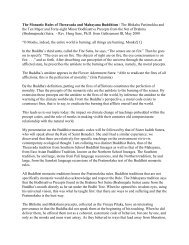
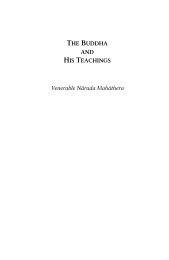


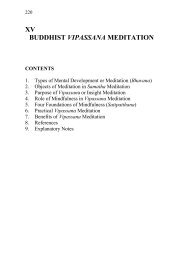

![Path of Freedom [Vimuttimagga] - Urban Dharma](https://img.yumpu.com/34050512/1/177x260/path-of-freedom-vimuttimagga-urban-dharma.jpg?quality=85)
